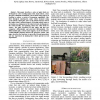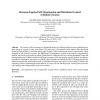246 search results - page 21 / 50 » Robot control with biological cells |
CDC
2008
IEEE
14 years 1 months ago
2008
IEEE
Abstract— A geometric optimization based approach to deploy a mobile sensor network for the purpose of detecting and capturing mobile targets in the plane is presented in [1]. Th...
ICRA
2010
IEEE
13 years 5 months ago
2010
IEEE
— We study target reaching tasks of redundant anthropomorphic manipulators under the premise of minimal energy consumption and compliance during motion. We formulate this motor c...
IROS
2007
IEEE
14 years 1 months ago
2007
IEEE
—This paper describes a series of gaits which we developed for a free crawling snake robot. Snake robots, a class of hyper-redundant mechanisms, can use their many degrees of fre...
AUTOMATICA
2010
13 years 7 months ago
2010
The ability of a robot team to reconfigure itself is useful in many applications: for metamorphic robots to change shape, for swarm motion towards a goal, for biological systems to...
AROBOTS
2004
13 years 7 months ago
2004
The control of robot swarming in a distributed manner is a difficult problem because global behaviors must emerge as a result of many local actions. This paper uses a bio-inspired ...


